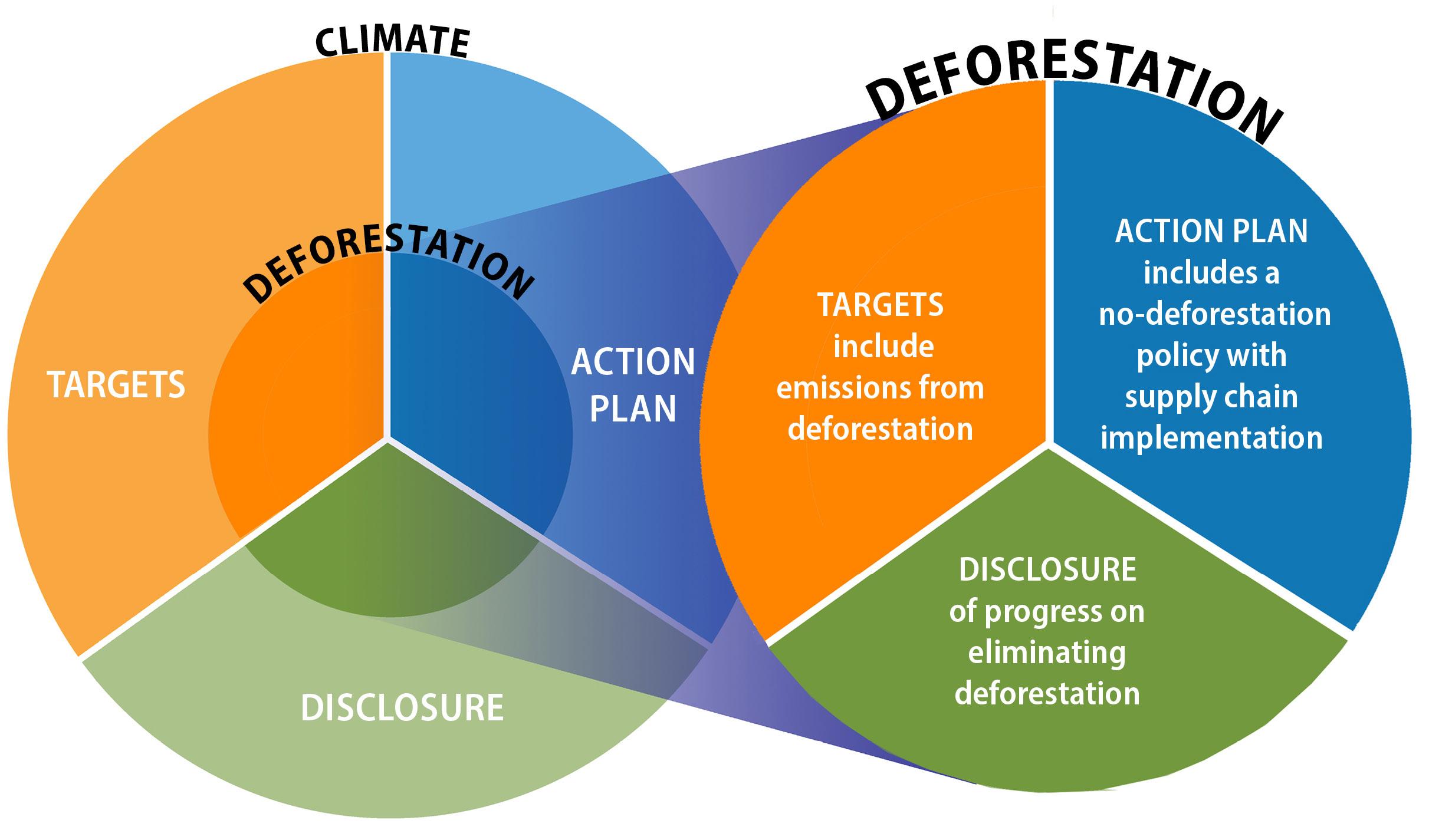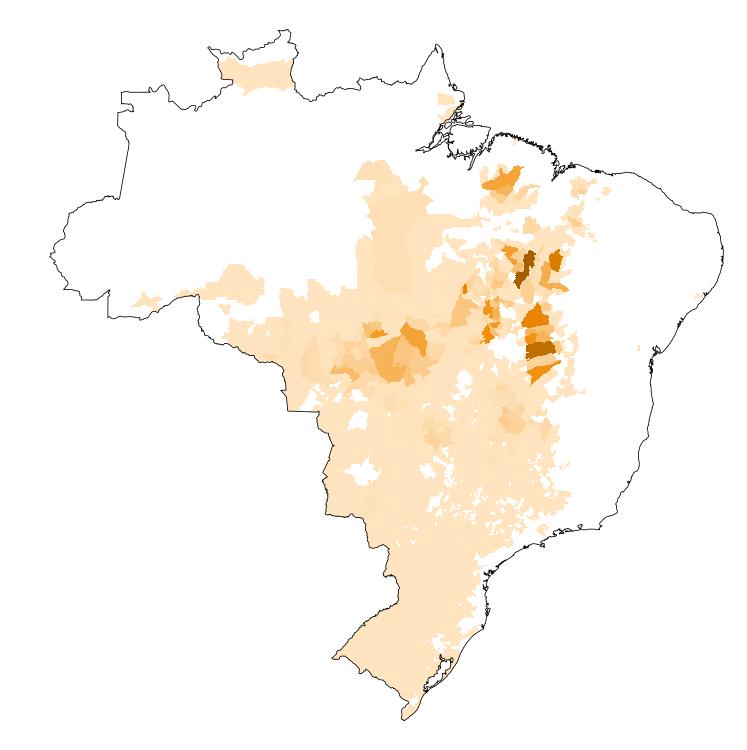
15 minute read
PART 5 Evaluating Corporate Actions and Engaging with Companies
Effective corporate response to climate change and deforestation should have three components: ambitious, time-bound GHG reduction targets that include deforestation emissions; a no-deforestation policy with strong supply chain implementation; and transparent disclosure of progress – or lack of progress –on both no-deforestation and climate targets. A company’s policies and implementation plan for eliminating deforestation from its supply chains must be a part of its overall climate strategy (Figure 9).

Advertisement
Figure 9 For companies with deforestation exposure, eliminating deforestation from supply chains should be a key component of corporate actions to address climate risk. Companies should: (1) include emissions from deforestation in their climate targets; (2) set and implement no-deforestation policies as part of their climate action plans; and (3) disclose on progress in eliminating deforestation and related emissions along with overall progress on climate targets.
The following pages outline specific policies and actions companies should use to reduce overall GHG emissions and eliminate deforestation in their supply chains. Investors can use this information to guide their engagements with companies, whether in specific dialogues, letters, meetings or shareholder resolutions focused on deforestation or climate change. The engagement framework and key performance indicators were developed in collaboration with Principles for Responsible Investment (PRI) and the investors participating in the Investor Initiative for Sustainable Forests.
Setting and implementing ambitious GHG reduction targets are key to addressing climate risk.
Eliminate GHG emissions from commodity driven deforestation Key elements
Targets are science-based and in line with what is needed to limit warming to 1.5 degrees Celsius. Targets cover a company’s full scope of emissions. Targets include emissions from land use change.
Science-based targets. A science-based target is a GHG emissions reduction target that aligns with what climate science says is necessary to limit global warming to 1.5 or well-below 2 degrees Celsius above pre-industrial levels. A company can ensure that its climate target aligns with global standards by seeking validation from the Science Based Targets initiative (SBTi). Investors can also engage companies to set interim reduction goals ahead of target deadlines to ensure they are on track.
Full scope of emissions. To be approved by SBTi, companies must set a target for scope 3 emissions if the company’s scope 3 emissions represent more than 40 percent of its total emissions when calculated using standards set by the GHG Protocol. For food and beverage companies, scope 3 sources are typically closer to 90 percent of a company’s total emissions, primarily from sourcing agricultural products.55
Emissions from land use change. The GHG emission inventory should include any emissions from agriculture and land use change associated with purchased raw materials, ingredients and services. This includes GHG emissions from deforestation and other land conversions, fertilizer use, emissions from livestock and rice production and other agricultural sources.
COMPANY CLIMATE TARGETS: KEY ENGAGEMENT QUESTIONS
• Does the company calculate scope 3 emissions including emissions from deforestation and land use change? • Are the company’s GHG reduction targets science-based and in line with a 1.5 degree scenario? • Does the company have GHG reduction targets for scope 1, 2, and 3 emissions, including emissions from deforestation land use changes?
BOARD LEVEL OVERSIGHT As part of their role as stewards of long-term company performance, corporate boards have a critical role to play in overseeing corporate sustainability strategies. The oversight should be closely aligned with company business models and operations. To fulfill this role, company boards should: include board members with sustainability expertise; establish committees with formal mandates focused on climate risks and opportunities; and create incentive structures linking executive compensation to performance on key sustainability commitments, including climate change and deforestation. For more details on this topic, please see the report, Climate Running the Risk: How Corporate Boards Can Oversee Environmental, Social and Governance (ESG) Issues.
Companies that source forest-risk commodities cannot meet full scope, science-based emissions reductions targets, as recommended in the previous section, without implementing comprehensive no-deforestation policies. Deforestation-related emissions contribute substantially to GHG emissions of companies that produce or source forest-risk commodities. Beef processors or palm oil traders may have deforestation-related emissions 8-10 times greater than their emissions from operations (scope 1) and electricity use (scope 2).56 Emissions from deforestation are also significant for companies downstream in the supply chain. Mars Inc., a U.S.-based food manufacturer, for example, estimated that 29 percent of the company’s total emissions are from deforestation and conversion associated with sourcing of raw materials from tropical countries.57
Sourcing decisions make a significant difference in a company’s deforestation-related GHG footprint. Within key countries of concern, deforestation is often most prevalent within certain municipalities. For example, 40 percent of deforestation-related GHG emissions from Brazilian soy production come from just 1 percent of soy-producing municipalities (Figure 10).58 Being able to trace a commodity beyond the country of origin allows companies to understand the actual GHG emissions associated with that commodity (see “Supply Chain Implementation” below). For example, the estimated total GHG footprint of a kilogram of soybeans varies dramatically depending on the deforestation in areas where it was grown. Eliminating deforestation could reduce the GHG footprint of soybeans by 39 percent on average (Figure 10). With this understanding, companies should engage suppliers in these crucial municipalities and work to enforce no-deforestation policies. By targeting efforts to address deforestation in this way, companies could dramatically reduce the deforestation-related GHG emissions from their sourcing.



Figure 10 GHG emissions per ton of soy traded from Brazil. The map on the left shows GHG emissions due to deforestation per ton of soy for each soy-producing municipality in Brazil. The chart on the right shows the difference in the total GHG footprint (GHG emissions per ton of soy) of soy produced with and without deforestation. The “without deforestation emissions” are due to transport, processing, and crop management practices such as fertilizer application. Data from Escobar et al. 2020. 59
To effectively mitigate deforestation-driven risks, companies should have robust no-deforestation policies with sufficient breadth and detail to eliminate deforestation from their supply chains. Investors should also engage companies on setting interim goals ahead of commitment deadlines. These recommendations are aligned with the Accountability Framework’s core principles of how companies should set, implement and monitor deforestation commitments.
No-Deforestation Policy Key elements
Policies should apply to all commodities and all regions where the company sources commodities. Policies should cover indirect suppliers as well as direct suppliers. Policies should be paired with time-bound commitments to eliminate deforestation.
Commodity coverage. No-deforestation policies should apply to all commodities sourced by a company. These policies should also include commodity-specific language, including a risk-based approach to expanding the policy beyond core raw materials. Policies should also cover all regions where commodities are being sourced or may be used for future sourcing.
Indirect supplier coverage. No-deforestation policies should cover entire supply chains including all indirect suppliers. Companies have more influence over direct (tier 1) suppliers and less influence over indirect (tier 2 and beyond) suppliers. However, in terms of material supply chain risks and overall GHG emissions, it is equally important for companies to understand and monitor indirect suppliers and where and how they are sourcing their commodities.
Time-bound commitments. Commitments to achieve deforestation-free supply chains should be linked to specific timeframes that are both achievable and contain sufficient urgency aligned with recognized global expectations. These commitments should also be quantifiable.
NO-DEFORESTATION POLICY: KEY ENGAGEMENT QUESTIONS
• Does the company have a no-deforestation policy that is publicly available? • Does the deforestation policy cover all commodities, especially key commodities such as beef & cattle, soy, palm oil and pulp/paper? • Does the policy apply to all geographies that the company sources from and all markets where the company operates?
NO-CONVERSION COMMITMENTS Although the definition of deforestation is limited to the loss of natural forests, other carbon-rich ecosystems are often converted for agricultural uses. For example, companies may source soybeans from the Brazilian Cerrado, which consists of a mix of forests, woodlands and grasslands. It is challenging to distinguish forests from other types of vegetation in this region, both practically and legally. The Accountability Framework recommends that companies with an existing deforestation commitment replace it with a no-conversion commitment for the Cerrado. In the future, companies will be expected to adopt no-conversion policies and commitments for all supply chains to ensure complete coverage of regions where important ecosystems, both forests and others, are being lost. Companies without an existing no-deforestation policy should consider a no-conversion policy to ensure future compliance with industry expectations. 24

A no-deforestation policy is only effective if the company ensures implementation of the policy throughout its supply chains. Companies should implement no-deforestation commitments by developing mechanisms for monitoring and verifying supplier compliance with corporate policies, addressing non-compliance, and incentivizing agricultural practices that protect forests.
Supply Chain Implementation (Monitoring, Evaluation and Incentives) Key elements
Companies should be able to trace their raw materials throughout their supply chains to a level that assures compliance with no-deforestation policies. Companies should monitor and verify supplier compliance with their no-deforestation policy. Companies should develop a protocol for suppliers that are not complying with the deforestation policy. Companies should provide incentives to producers to protect forests.
Traceability to origin. Traceability, or the ability to track a commodity along a supply chain, allows a company to maintain transparency and ensure that its suppliers are complying with company polices. Primary processors and traders of commodities should be able to trace commodities from direct and indirect suppliers to the farm, estate, plantation, ranch, or forest management unit where they were produced (point of origin). Downstream buyers such as manufacturers and retailers should be able to trace commodities from direct and indirect suppliers to the point at which the company can assure compliance with its policies (point of control). Traceability is critical given that a commodity’s emissions from deforestation may vary widely depending on where within a country it was produced (Figure 10).
Monitoring and verification of full supply chains. Companies should implement robust monitoring and verification processes to ensure suppliers are complying with its policies. For even the most downstream companies, monitoring and verifying supplier compliance to these policies is crucial. Simply put, complete scope 3 emissions disclosure, including deforestation emissions, cannot be calculated without full traceability.
• Third party verification. If possible, the verification process should be done by an independent third-party to ensure that sourced products adhere to the company’s policies as well as broader industry and nonprofit standards • Grievance mechanisms. A grievance mechanism is a formal, legal or non-legal complaint process that individuals, workers, communities and/or civil society organizations can use to report instances where certain business activities and operations negatively affected them. Effective grievance mechanisms are a crucial component of corporate human rights due diligence and can protect companies from reputational and litigation risks. Companies should develop and disclose a clear process for stakeholders to report deforestation, including disclosure of its process for investigating grievances. • Non-compliance protocols. The verification process should include protocols for supplier non-compliance, including suspensions and facilitation of time-bound action plans to return suppliers to compliance.
Supplier/producer incentives. Companies should help suppliers transition away from deforestation by providing educational opportunities, technical training, financial support and other resources necessary to avoid further deforestation.
• Is the company working towards traceability to a commodity’s point of origin for both direct and indirect suppliers? • Does the company disclose supplier locations and if not, what are the challenges to providing this disclosure?
• Does the company have systems in place to monitor operations and suppliers for compliance with no-deforestation policies?
NET-ZERO VS. NO-DEFORESTATION AND THE ROLE OF FOREST RESTORATION Companies differ in how they phrase their deforestation policies, but there is one word that makes a big difference: “net.” No-deforestation Does not allow for any deforestation in supply chains, whether legal or illegal. This is also referred to as “zero-gross” deforestation. Net-zero deforestation Allows for deforestation as long as the same area of forest lost is reforested elsewhere. No-deforestation is a more robust commitment because: • Reforestation does not negate reputational risks that companies face by having deforestation exposure in their supply chains. Deforestation events can still be linked to their supply chains by monitoring organizations. • Reforestation is not a substitute for protecting existing forests. Forests and other natural ecosystems store large amounts of “irrecoverable carbon”—carbon that is vulnerable to release upon land use conversion, and once lost, cannot be re-sequestered in time to avoid catastrophic climate change.60
When done in tandem with protecting existing forests, reforestation is a critical part of the solution to climate change. But it must be done carefully. Reforestation projects must respect the land rights and livelihoods of local people, especially indigenous communities. Moreover, reforestation efforts should aim to restore biodiverse natural forests, not create monoculture tree plantations.

Public disclosure of progress towards targets holds companies accountable to their commitments. By monitoring key climate and deforestation indicators for incremental progress, companies can make strategic adjustments to ensure they are reducing their risks.
Company discloses progress of eliminating deforestation and related emissions Key elements
Companies publicly and regularly disclose quantifiable progress to eliminate deforestation from their supply chains. Companies disclose quantifiable progress on GHG emissions reductions from land use change.
Quantifiable progress on eliminating deforestation. Few companies disclose quantitative progress toward eliminating deforestation from their commodity supply chains. As a result, it is difficult for investors to understand, analyze and mitigate risks within their portfolios. Given improving and increasingly accessible datasets and traceability tools, companies should report on the following metrics, which provide deep insights into corporate progress and impacts:
•Percent of a commodity that is traceable. Traceability reporting should include the percentage of a sourced commodity a company can trace to the product’s origin or to a point at which the company can assure compliance with its policies.
• Percent of suppliers in compliance. Companies should disclose the percentage of their total suppliers that comply with their no-deforestation policies. They should also update these numbers to reflect recent suspensions due to non-compliance.
• Percent of commodity in compliance. Companies should disclose how much of their total supply of a commodity is in compliance with company policies and standards. This is particularly important when a company sources most of a commodity from just a few suppliers
Quantifiable progress towards GHG emissions reduction targets. Companies should disclose either percentage progress towards its full scope GHG emissions-reductions targets or percentage reductions from its baseline emissions on an annual basis.
DISCLOSURE OF PROGRESS: KEY ENGAGEMENT QUESTIONS • Does the company disclose quantitative progress towards its no-deforestation and climate commitments on an annual basis?
• Does the company disclose progress on its no-deforestation and climate commitments in its own publications and third-party platforms such as CDP? • Does the company disclose the percentage of its suppliers and percentage of the volume of commodities being sourced in compliance with its no-deforestation policy?
Below are examples of companies working to address deforestation in their commodity supply chains and areas where they can further improve their commitments and actions.
Company climate targets Mondelez, a US-based food company, reports annually to the CDP Climate questionnaire. According to its responses, the company has climate-related board-level oversight, including a Governance, Membership, and Public Affairs Committee on its Board of Directors that is responsible for overseeing sustainability as a part of its Snacking Made Right Impact Strategy. The company calculates the full scope of its GHG footprint on an annual basis, and in 2019, it included emissions from land use change in its emissions reporting to CDP. As of January 2020, Mondelez has a GHG reductions target approved to be aligned with a well-below 2-degree scenario by the SBTi. This target commits the company to reducing absolute scope 1, 2, and 3 GHG emissions by 10 percent by 2025, from a 2018 base year.
→ Mondelez can further strengthen its commitment by setting a target aligned with a 1.5-degree scenario.
No-deforestation policy In its Sustainable Palm Oil Sourcing policy, consumer giant Unilever outlines specific plans for its palm oil supply chains, such as commitments to source palm oil with no deforestation, no peat developments and no conversion of High Carbon Stock (HCS) and High Conservation Value (HCV) forests. However, the company only commits to zero-net deforestation in its beef, palm oil, soy, and pulp and paper supplies by 2020.
→ Unilever can improve its no-deforestation policy by committing to zero-gross deforestation and disclosing a post-2020 plan.
Supply chain implementation Wilmar, one of the world’s largest palm oil plantation owners and processors, is working towards complete traceability to the mill level, including GPS coordinates for both direct and indirect suppliers and publicly disclosing the location of its refineries. In Malaysia and Indonesia, Wilmar has identified all supplying mills for its refineries and discloses information on the percentage of palm oil from each mill that is traceable to the plantation of origin. The company also has three monitoring and verifications programs that collect and assess data regarding supplier compliance with its No Deforestation, No Peat, No Exploitation (NDPE) policy. The company’s Grievance Unit, Suspensions Committee and Verification Team work together to: assess any grievances regarding its NDPE policy; suspend contracts with suppliers when necessary; and develop timebound action plans to return suppliers to compliance.
→ Wilmar could improve transparency by disclosing the percentage of palm oil suppliers covered by its monitoring and verification process.
Disclosure of progress Nestlé has reported to the CDP Forests questionnaire annually between 2014 and 2017. While it declined to respond to CDP Forests in 2018 and 2019, the company continues to disclose its progress in its sustainability reporting, such as in its 2018 Creating Shared Value report. According to Nestlé’s Implementing Responsible Sourcing report, it has achieved traceability for 54 percent of its palm oil supply to the plantation, 78 percent of its soy supply to the mill, and 32.5 percent of its meat, poultry and egg supplies to the farm level. Nestlé also discloses lists its Tier 1 suppliers and supplying mills for palm oil. As of 2017, 60 percent of its palm oil, 76 percent of its soy, and 99 percent of its meat supply was free from deforestation. Nestlé also responds to the CDP Climate questionnaire annually and reports on progress towards its SBTi-approved target.
→ To improve transparency, Nestlé should respond to future CDP questionnaires, provide specific details on the traceability of its beef supply and disclose the percentage of its suppliers that are in compliance with its policies.








